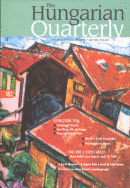Bartók’s Great Crescendos - Some Observations for Young Musicians
Bartók’s Great Crescendos - Some Observations for Young Musicians
Author(s): László SomfaiSubject(s): Music
Published by: Society of the Hungarian Quarterly
Keywords: Béla Bartók; Bartók’s piano playing
Summary/Abstract: Béla Bartók’s mature music is essentially non-Classical (though the large-scale instrumental works composed between 1926 and 1937 may be said to have Classical ambitions); the entirety of his oeuvre and his whole artistic personality are fundamentally Romantic. On several occasions, I have tried to find the right form to express this conviction of mine, but a number of my colleagues have disagreed, whether they said so openly or not. The problem derives, in part, from the divergence between aesthetic terminology and musicians’ everyday talk. In the case of composers, ‘Classical’ often implies a value judgment (more valuable and more noble, more enduring than ‘Romantic’ art), and given the fact that Bartók himself affirmed that his new style had arisen as a reaction to the excesses of nineteenthcentury Romantic music, we ought to spare him the disparaging ‘Romantic’ epithet. (It has to be noted, though, that after 1930, Bartók only distanced himself from “excessive sentimentality”, not Romanticism as such.) Yet, if we keep the dichotomy of Apollonian and Dionysian attitudes in mind as we try to determine the basic traits of Bartók’s personality and music within the context of a great historic era of the past (the classics of the twentieth century: Schoenberg, Bartók, Stravinsky), then Bartók’s powerful Romantic attributes begin to appear in a positive light.
Journal: The Hungarian Quarterly
- Issue Year: 2006
- Issue No: 183
- Page Range: 156-168
- Page Count: 13
- Language: English

